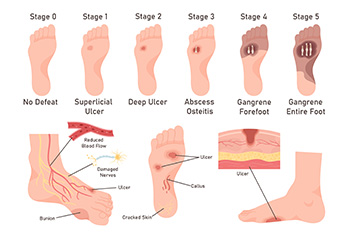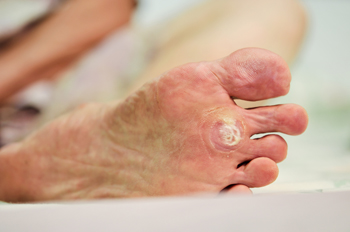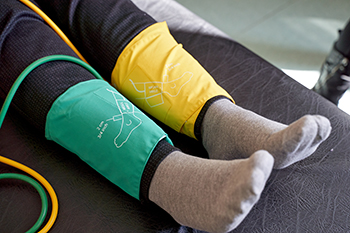Connect With Us
Items filtered by date: September 2024
Diabetic Foot Ulcers Cause Foot Pain

A diabetic foot ulcer is a serious complication of diabetes, characterized by a sore or wound on the foot that is slow to heal. These ulcers often develop due to poor blood circulation and nerve damage, common in diabetic patients. Risk factors include uncontrolled blood sugar levels, peripheral artery disease, and neuropathy, which diminishes sensation in the feet making injuries less noticeable. The progression of a diabetic foot ulcer typically begins with minor wounds or blisters that fail to heal properly. Over time, these can deepen and become infected, leading to more severe complications if not treated promptly. If you have developed a foot ulcer, whether or not it is related to diabetes, it is suggested that you are under the care of a podiatrist who can effectively treat this condition.
Foot Pain
Foot pain can be extremely painful and debilitating. If you have a foot pain, consult with one of our podiatrists from The Podiatry Center, PC. Our doctors will assess your condition and provide you with quality foot and ankle treatment.
Causes
Foot pain is a very broad condition that could be caused by one or more ailments. The most common include:
- Bunions
- Hammertoes
- Plantar Fasciitis
- Bone Spurs
- Corns
- Tarsal Tunnel Syndrome
- Ingrown Toenails
- Arthritis (such as Gout, Rheumatoid, and Osteoarthritis)
- Flat Feet
- Injury (from stress fractures, broken toe, foot, ankle, Achilles tendon ruptures, and sprains)
- And more
Diagnosis
To figure out the cause of foot pain, podiatrists utilize several different methods. This can range from simple visual inspections and sensation tests to X-rays and MRI scans. Prior medical history, family medical history, and any recent physical traumatic events will all be taken into consideration for a proper diagnosis.
Treatment
Treatment depends upon the cause of the foot pain. Whether it is resting, staying off the foot, or having surgery; podiatrists have a number of treatment options available for foot pain.
If you have any questions, please feel free to contact our office located in Millburn, NJ . We offer the newest diagnostic and treatment technologies for all your foot care needs.
It's Time for Beautiful Feet
Symptoms and Transmission of Plantar Warts

Plantar warts are benign growths that appear on the soles of the feet due to a viral infection caused by the human papillomavirus, or HPV. These warts often develop on weight-bearing areas, such as the heels or balls of the feet, that make walking uncomfortable. Symptoms typically include small, rough, and grainy lesions that may have tiny black dots within them. They can also cause pain or discomfort when standing or walking. Plantar warts spread through direct contact with the virus, which thrives in warm, moist environments, like swimming pools or communal showers. The virus enters the skin through small cuts or abrasions. Maintaining good foot hygiene and avoiding walking barefoot in public places can help reduce the risk of contracting and spreading plantar warts. If you have developed a plantar wart, it is suggested that you schedule an appointment with a podiatrist who can treat it accordingly.
Plantar warts can be very uncomfortable. If you need your feet checked, contact one of our podiatrists from The Podiatry Center, PC. Our doctors will assist you with all of your foot and ankle needs.
About Plantar Warts
Plantar warts are the result of HPV, or human papillomavirus, getting into open wounds on the feet. They are mostly found on the heels or balls of the feet.
While plantar warts are generally harmless, those experiencing excessive pain or those suffering from diabetes or a compromised immune system require immediate medical care. Plantar warts are easily diagnosed, usually through scraping off a bit of rough skin or by getting a biopsy.
Symptoms
- Lesions on the bottom of your feet, usually rough and grainy
- Hard or thick callused spots
- Wart seeds, which are small clotted blood vessels that look like little black spots
- Pain, discomfort, or tenderness of your feet when walking or standing
Treatment
- Freezing
- Electric tool removal
- Laser Treatment
- Topical Creams (prescription only)
- Over-the-counter medications
To help prevent developing plantar warts, avoid walking barefoot over abrasive surfaces that can cause cuts or wounds for HPV to get into. Avoiding direct contact with other warts, as well as not picking or rubbing existing warts, can help prevent the further spread of plantar warts. However, if you think you have developed plantar warts, speak to your podiatrist. He or she can diagnose the warts on your feet and recommend the appropriate treatment options.
If you have any questions please feel free to contact our office located in Millburn, NJ . We offer the newest diagnostic and treatment technologies for all your foot and ankle needs.
Risk Factors for Plantar Fasciitis

Plantar fasciitis, a common cause of heel pain, often results from strain on the plantar fascia, a thick band of tissue that supports the foot's arch. Various risk factors can contribute to plantar fasciitis, including excessive foot pronation, where the foot rolls inward too much, or high arches that put extra stress on the fascia. Tightness in the Achilles tendon can limit ankle movement, which in turn increases strain on the plantar fascia. Weak foot muscles may also contribute to overstretching the plantar fascia. Physical activity levels, whether too much or too little, can also influence the development of plantar fasciitis. Prolonged standing, obesity, and training errors, such as sudden increases in exercise intensity, are additional risk factors. Addressing these issues early with a podiatrist can help prevent the condition from worsening. If you have persistent or worsening heel pain, it is suggested that you promptly schedule an appointment with a podiatrist to determine whether plantar fasciitis is the problem.
Plantar fasciitis can be very painful and inconvenient. If you are experiencing heel pain or symptoms of plantar fasciitis, contact one of our podiatrists from The Podiatry Center, PC. Our doctors can provide the care you need to keep you pain-free and on your feet.
What Is Plantar Fasciitis?
Plantar fasciitis is the inflammation of the thick band of tissue that runs along the bottom of your foot, known as the plantar fascia, and causes mild to severe heel pain.
What Causes Plantar Fasciitis?
- Excessive running
- Non-supportive shoes
- Overpronation
- Repeated stretching and tearing of the plantar fascia
How Can It Be Treated?
- Conservative measures – anti-inflammatories, ice packs, stretching exercises, physical therapy, orthotic devices
- Shockwave therapy – sound waves are sent to the affected area to facilitate healing and are usually used for chronic cases of plantar fasciitis
- Surgery – usually only used as a last resort when all else fails. The plantar fascia can be surgically detached from the heel
While very treatable, plantar fasciitis is definitely not something that should be ignored. Especially in severe cases, speaking to your doctor right away is highly recommended to avoid complications and severe heel pain. Your podiatrist can work with you to provide the appropriate treatment options tailored to your condition.
If you have any questions please feel free to contact our office located in Millburn, NJ . We offer the newest diagnostic and treatment technologies for all your foot and ankle needs.
Heel Pain Can Be Treated!
Peripheral Artery Disease in the Feet

Peripheral arterial disease, or PAD, is a condition where narrowed arteries reduce blood flow to the limbs, particularly the lower legs and feet. This reduced circulation can lead to pain, cramping, and fatigue in the legs and feet, especially during physical activities like walking. Over time, PAD can result in more serious complications, such as sores or wounds on the feet that heal slowly, if at all, and an increased risk of infections. Symptoms of PAD include leg pain while walking, numbness or weakness, coldness in the lower leg or foot, and changes in skin color. Causes of PAD are typically related to atherosclerosis, where fatty deposits build up on artery walls. Risk factors include smoking, diabetes, high blood pressure, and high cholesterol. If you experience symptoms of PAD, it is strongly suggested that you visit a podiatrist for early diagnosis and management. Treatment may include lifestyle changes, medication, and, in severe cases, surgery to improve blood flow.
Peripheral artery disease can pose a serious risk to your health. It can increase the risk of stroke and heart attack. If you have symptoms of peripheral artery disease, consult with one of our podiatrists from The Podiatry Center, PC. Our doctors will assess your condition and provide you with quality foot and ankle treatment.
Peripheral artery disease (PAD) is when arteries are constricted due to plaque (fatty deposits) build-up. This results in less blood flow to the legs and other extremities. The main cause of PAD is atherosclerosis, in which plaque builds up in the arteries.
Symptoms
Symptoms of PAD include:
- Claudication (leg pain from walking)
- Numbness in legs
- Decrease in growth of leg hair and toenails
- Paleness of the skin
- Erectile dysfunction
- Sores and wounds on legs and feet that won’t heal
- Coldness in one leg
It is important to note that a majority of individuals never show any symptoms of PAD.
Diagnosis
While PAD occurs in the legs and arteries, Podiatrists can diagnose PAD. Podiatrists utilize a test called an ankle-brachial index (ABI). An ABI test compares blood pressure in your arm to you ankle to see if any abnormality occurs. Ultrasound and imaging devices may also be used.
Treatment
Fortunately, lifestyle changes such as maintaining a healthy diet, exercising, managing cholesterol and blood sugar levels, and quitting smoking, can all treat PAD. Medications that prevent clots from occurring can be prescribed. Finally, in some cases, surgery may be recommended.
If you have any questions, please feel free to contact our office located in Millburn, NJ . We offer the newest diagnostic and treatment technologies for all your foot care needs.
Blog Archives
- April 2025
- March 2025
- February 2025
- January 2025
- December 2024
- November 2024
- October 2024
- September 2024
- August 2024
- July 2024
- June 2024
- May 2024
- April 2024
- March 2024
- February 2024
- January 2024
- December 2023
- November 2023
- October 2023
- September 2023
- August 2023
- July 2023
- June 2023
- May 2023
- April 2023
- March 2023
- February 2023
- January 2023
- December 2022
- November 2022
- October 2022
- September 2022
- August 2022
- July 2022
- June 2022
- May 2022
- April 2022
- March 2022
- February 2022
- January 2022
- December 2021
- November 2021
- October 2021
- September 2021
- August 2021
- July 2021
- June 2021
- May 2021
- April 2021
- March 2021
- February 2021
- January 2021
- December 2020
- November 2020
- October 2020
- September 2020
- August 2020
- July 2020
- June 2020
- May 2020
- April 2020
- March 2020
- February 2020
- January 2020
- December 2019
- November 2019
- October 2019
- September 2019
- August 2019
- July 2019
- June 2019
- May 2019
- April 2019
- March 2019
- February 2019
- January 2019
- December 2018
- November 2018
- October 2018
- September 2018
- August 2018
- July 2018
- June 2018
- May 2018
- April 2018
- March 2018
- February 2018
- January 2018
- December 2017
- November 2017
- October 2017
- September 2017
- August 2017
- July 2017
- June 2017
- May 2017
- April 2017
- March 2017
- February 2017
- January 2017
- December 2016
- November 2016
- October 2016
- September 2016
- August 2016
- July 2016
- June 2016
- May 2016
- April 2016
- March 2016
- February 2016
- January 2016
- December 2015
- November 2015
- October 2015
- September 2015
- August 2015
- July 2015
- June 2015
- May 2015
- January 2014
- December 2013
- November 2013
- October 2013
- September 2013
- August 2013
- July 2013
- June 2013
- May 2013
- April 2013
- March 2013
- February 2013
- January 2013
- December 2012
- November 2012
- October 2012
- September 2012
- August 2012
- July 2012
- June 2012


